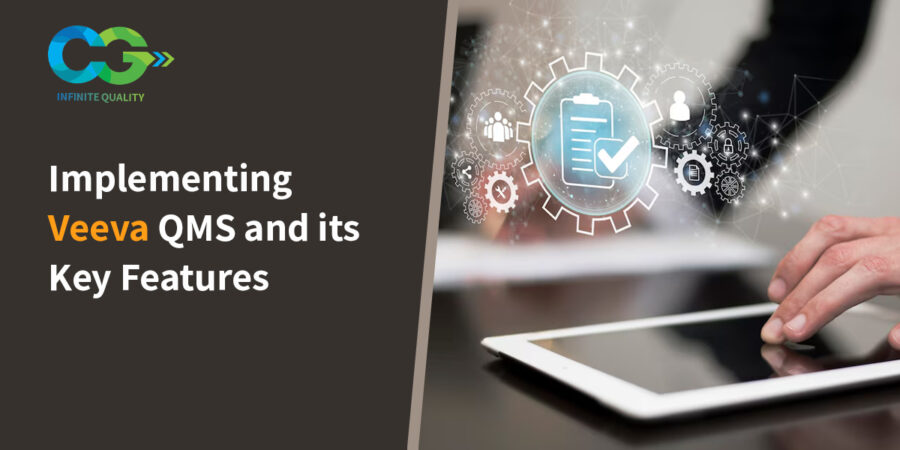
Article Context:
Veeva Quality Management is a cloud-based solution designed to streamline and automate quality processes for regulated industries such as life sciences. This is an application that manages global quality across an organization and its external partners. Implementing Veeva Vault QMS involves a structured approach to ensure successful deployment and utilization of its key features. Here's a step-by-step guide along with the key features to focus on during implementation:
Key Features:
- Document Management: Centralize and control quality documents such as standard operating procedures (SOPs), policies, work instructions, and specifications in a centralized repository. This helps ensure compliance with regulatory requirements and enables efficient document collaboration and revision control.
- Quality Events: Manage deviations, non-conformances, complaints, and CAPAs (Corrective and Preventive Actions). It streamlines the investigation, root cause analysis, and resolution processes, helping organizations identify and address quality issues in a timely manner.
- Change Control: Veeva Quality Management enables organizations to manage change control processes effectively, including assessing the impact of proposed changes, obtaining approvals, and implementing changes while maintaining compliance with regulatory requirements.
- Training Management: Ensure employees are trained in relevant quality procedures and processes. This helps organizations maintain a compliant workforce and improve overall quality performance.
- Audit Management: Facilitates audit planning, execution, and follow-up activities, helping organizations manage internal and external audits more efficiently. It provides features such as audit scheduling, checklist management, findings management, and corrective action tracking.
- Compliance and Reporting: The platform offers capabilities for monitoring compliance with regulatory requirements and industry standards. It provides reporting and analytics tools that enable organizations to track key quality metrics, identify trends, and drive continuous improvement initiatives.
Step 1: Define Objectives and Scope
- Collaborate with Veeva certified Compliance Group experts to identify and document specific quality management objectives and requirements tailored to your organization.
- Work with Compliance Group to determine the scope of implementation, including necessary Veeva Vault QMS modules and features.
Step 2: Assessment and Planning
- Develop a detailed project plan with clear timelines, milestones, and resource allocations.
- Assemble a cross-functional implementation team with Compliance Group experts and representatives from quality, IT, compliance, and relevant departments.
Step 3: Configuration and Customization
- Work closely with Compliance Group experts to configure Veeva Vault QMS according to your organization's specific needs.
- Customize the system to automate and streamline quality management processes.
- Electronic Signatures and Approval Workflows: Implement electronic signatures and automated approval workflows to ensure compliance.
- Role-based Access Control: Define roles and permissions to control access to sensitive quality information.
- Configurability: Customize workflows, forms, templates, and reports to align with your organization's processes.
- Integration: Integrate Veeva Vault QMS with other systems such as ERP, LIMS, and document management systems.
Step 4: Data Migration
- Work with Compliance Group experts to develop and execute a robust data migration plan, ensuring data integrity and compliance.
- Validate, and migrate data in a phased approach, starting with critical datasets.
- Data Import: Use tools provided by Veeva or third-party solutions to import data from legacy systems.
Step 5: User Training
- CG experts will conduct comprehensive user training sessions, tailored to different roles within the organization.
Step 6: Testing and Validation
- CG experts leads the testing and validation phases, ensuring all regulatory requirements are met..
- Audit Trails: Maintain detailed audit trails of user activities for compliance and accountability.
Step 7: Rollout and Deployment
- Gradually rollout Veeva Vault QMS, supported by CG experts to ensure a smooth transition.
- Communicate effectively with stakeholders about the rollout plan, timelines, and expectations.
Step 8: Continuous Improvement
- With CG experts guidance, establish continuous improvement processes, staying informed about updates and best practices from Veeva.
Step 9: Compliance and Governance
- CG experts implements and oversees robust governance processes, maintaining documentation, audit trails, and change control procedures.
By following these steps and leveraging expertise of Veeva certified Compliance Group, you can ensure a smooth, compliant, and efficient transition to Veeva QMS. Are you struggling with Veeva implementation and validation? Contact us at sales@complianceg.com today to learn how our expert validation services can streamline your process and ensure regulatory compliance.

AUTHOR:
Ramya Koppolu
Sr. Validation Lead, Validation & Compliance
